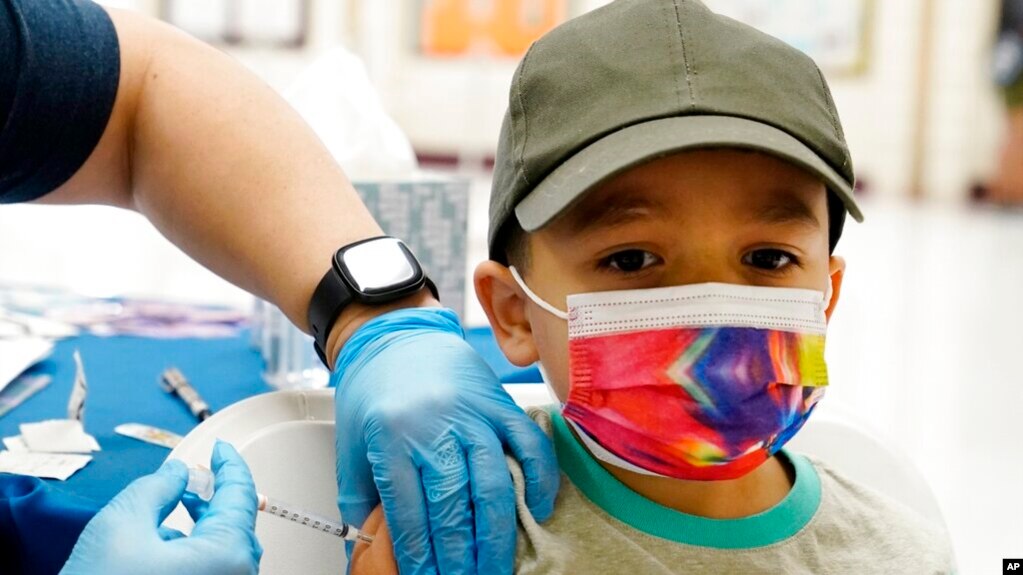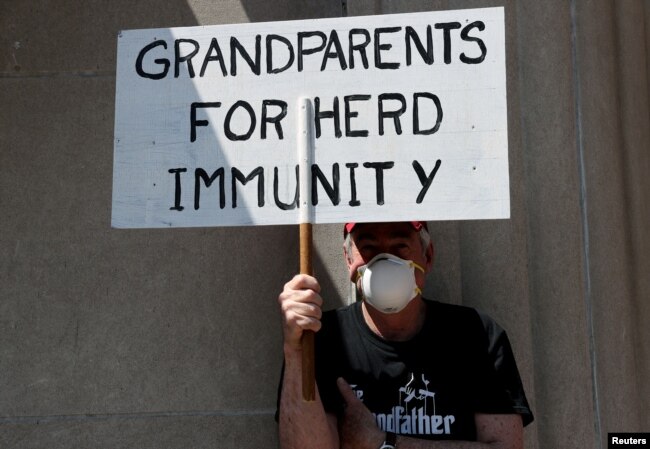
Oliver Estrada, 5, receives the first dose of the Pfizer COVID-19 vaccine at an Adelante Healthcare community vaccine clinic at Joseph Zito Elementary School, Nov. 6, 2021, in Phoenix, Arizona. (AP Photo/Ross D. Franklin)
There was so much to look forward to at the start of 2021.
The question was when, and not if, the health crisis that spread from a market in Wuhan, China would finally end.
Scientists developed two highly effective vaccines against the coronavirus in record time. Several more were waiting for approval.
Vaccines
Governments in the United States, Europe, and Israel spent billions of dollars to start the biggest vaccination program in history. The effort included vaccines from drug companies Pfizer-BioNTech, Moderna and others.
China and Russia developed their own vaccines. And the UN-backed COVAX program purchased shots for developing and poor countries around the world.
In May, the U.S. and Western nations expanded the program to vaccinate young children. Health officials issued new guidelines advising that fully vaccinated people no longer needed to wear face coverings in most situations. The move was seen as the first step toward returning to normal conditions that existed before the pandemic.

Variants
But, scientists began to worry about the new versions of the coronavirus, called variants, soon after people started to receive the new vaccines.
It is normal for viruses to mutate, or change, over time. A mutation that strengthens the virus helps it to spread by pushing out the weaker versions. In February, the head of Britain’s vaccination effort said the world faced around 4,000 variants of the virus that causes COVID-19. But only some would raise concern.
There were so many “variants of concern” with hard-to-remember scientific names that the World Health Organization (WHO) started to name them after the letters of the Greek alphabet. The two most worrisome variants now are Delta and Omicron.
In the early days of the pandemic, many Asian countries appeared to have successfully fought the virus with strong measures. By July, countries, including Japan, South Korea, Vietnam, and Thailand, were setting records for new cases and deaths. The Delta variant appeared at a difficult time. When it started being reported, vaccination rates remained low in many countries. And officials were moving quickly to reopen economies. Then, infections of the Delta variant became widespread. Governments, businesses, and schools reacted with more vaccination requirements and restrictions.

Some countries started to restrict international travelers and closed borders over concerns about the fast-spreading Omicron variant. The U.S., Israel, Britain, and other nations now advised their citizens to get an additional shot, called a booster, to fight the new variant.
Will it ever disappear?
After another year of face coverings, restrictions, vaccines and variants, people are beginning to wonder whether this pandemic will ever go away.
The answer is yes and no.
Many scientists believe that the new coronavirus is here to stay. In February, the science publication Nature reported the results of a study involving more than 100 scientists. Eighty-nine percent said they believed the SARS-CoV-2 virus, the one that causes COVID-19 disease, will become endemic. Endemic means the virus will continue to exist in some areas for years to come.
For example, Malaria is considered endemic to many warm, wet areas across countries in Asia, Africa, and South America. But it is not a problem in the United States or other Western nations.

The way to end a pandemic is to reach herd immunity. Herd immunity is when many people in a community either have recovered from an infection or have been vaccinated. It does not mean everyone is protected from the virus. However, when herd immunity is reached, the virus can no longer spread easily, which helps protect those who are at risk.
As nations joined together to fight the pandemic, health officials started to sound the alarm about another public health crisis: mental health.
The U.S. Surgeon General said the pandemic’s high number of deaths, forced social distancing, and lockdowns of the economies have created new pressure, especially on young people.
He wrote, “It would be a tragedy if we beat back one public health crisis only to allow another to grow in its place.”

Hopeful signs
There is hope, however.
In early November, American drug-maker Pfizer reported that its experimental antiviral pill for COVID-19 cuts hospitalizations and death rates by nearly 90 percent in high-risk adults. This came after Merck had reported success in testing its version of the COVID-19 pill a month earlier.
Although health officials have already approved several treatments for COVID-19, all of them must be injected by healthcare workers. But pills can be taken at home and are easier to send around the world.
Both companies have since agreed to provide other drug-makers with special permission to produce the COVID pills. The move is aimed at helping people in poorer countries get the drug.
I’m Caty Weaver. And I’m Mario Ritter, Jr.
Hai Do wrote this story for Learning English. Mario Ritter, Jr. was the editor.
Quiz — Another Year of COVID-19, Variants and Restrictions
Start the Quiz to find out
_________________________________________________
Words in This Story
allow –v. to permit something to happen, for example, to be used or sold
pill –n. a small, rounded object that you swallow and that contains medicine, vitamins, or some treatment
We want to hear from you. Write to us in the Comments section, and visit WWW.VOA-STORY.COM